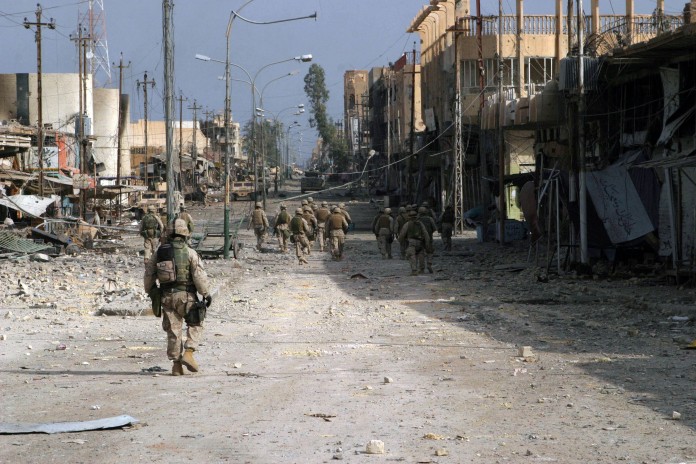
Iraq’s military fully reclaimed this northern city from the Islamic State on Sunday in a rapid campaign that defied expectations that the extremist group would put up a fierce resistance in one of its last major strongholds.
The battle for Tal Afar, which lasted just eight days, highlighted the diminished capabilities of the Islamic State in Iraq a month after it lost the key bastion of Mosul to a coalition of Iraqi forces backed by U.S.-led airstrikes and is likely to determine how future fights against the militant group will be executed.
Senior Iraqi military officers said the group has lost the will to fight in the face of a motivated and increasingly more professional military and are advocating that Prime Minister Haider al-Abadi authorize his armed forces to launch simultaneous battles for the last major cities that the Islamic State controls
Since the Islamic State took over nearly one-third of Iraq’s territory in 2014, Abadi has opted to reclaim cities one by one while the U.S. and other Western nations helped to rebuild Iraq’s armed forces, which collapsed during the Islamic State blitz.
Now, with more than three years of combat experience, Iraq’s security forces are eager to quicken the pace of the fight, with some commanders urging that the battles for the two remaining Islamic State strongholds, Hawija and Qaim, be launched at the same time.
“The enemy’s back is broken,” said Lt. Gen. Sami al-Aridhi, a top commander of the elite counterterrorism service units in Tal Afar. “Their morale is gone.”
Aridhi is among a cadre of influential commanders who believe the main branches of Iraq’s armed forces – the army, federal police and counterterrorism service – are capable of fighting concurrent battles.
Those forces, along with 12 brigades of mostly Shiite militias, attacked Tal Afar from three fronts, breaking Islamic State defense lines on the edges of the city before rapidly advancing to the city center.
The troops were surprised by what Col. Arkan Fadhil, a counterterrorism service officer, called a “controlled resistance” by small clusters of Islamic State fighters and the near- total lack of civilians in the city.
Ahead of the battle, Iraq’s government and its U.S. military partners had estimated that 10,000 to 50,000 civilians remained in Tal Afar under desperate conditions. The city had been surrounded by the Shiite militias since late November as Iraq’s armed forces waged the grueling nine-month battle for Mosul, about 40 miles to the east.
At the same time, U.S. and Iraqi airstrikes were pounding the city, an important way station for the Islamic State to move fighters and resources between the territory it controlled in Syria and Iraq.
The desolate city provided ample room for Iraqi troops to use heavy weaponry without fear of killing civilians. That use of firepower, along with the months-long siege, apparently sapped Islamic State’s fighters of the ability to effectively use their most ferocious weapons: car and truck bombs rigged with armor, commanders said.
“We haven’t seen a single civilian, dead or alive,” Aridhi said. “If there were 20,000 civilians in Tal Afar, we would have only just taken the first neighborhood by now.”
The large presence of civilians had complicated the battle for Mosul and led to high casualties. The exact number of civilian casualties has yet to be released by the government.
Along with the absence of residents, the number of Islamic State fighters in Tal Afar appeared to be vastly overstated. Before the operation was launched, Iraq’s intelligence services estimated that between 1,400 and 2,000 militants occupied the city. Iraq’s military said Saturday that they had killed 259 fighters, indicating that many had fled the battle into the vast desert north and west of the city toward Syria.
Unlike Mosul and cities like Fallujah, administrative centers that also housed Islamic State families, the dusty Tal Afar did not appear to be much more than a military outpost for the group.
Houses inside the city appeared unlived in and were stocked with material to manufacture explosives and store military gear. In one house inside the Kifah neighborhood, the rooms were full of hundreds of feet of coiled wires, apparently used to make improvised explosive devices, and discarded tactical vests and sawed-off rifle butts.
Two rusting trucks, outfitted with metal plates to turn them into devastating armored bombs, were left unfinished in a garage.
“The siege worked in preventing the enemy from getting all the materials they needed to build explosives,” said Maj. Raji al-Amidi of the counterterrorism service.
The swift collapse of the militancy in Tal Afar was unexpected. The city had a unique standing in the Islamic State’s hierarchy, with several top figures in the group and deputies to leader Abu Bakr al-Baghdadi hailing from Tal Afar. Along with its strategic location, just 40 miles east of the border with Syria, it was one of the few places the Islamic State occupied despite the large presence of Shiites there, making it an important propaganda tool for a group with a stated goal of exterminating Shiites in Iraq.
With the Shiite militias surrounding the city and participating in the bid to reclaim it from the Islamic State, experts had expected the militants to fight fiercely and try to inflict as much damage as possible before ceding the city, said Hisham al-Hashimi, who has advised the Iraqi government.
“Tal Afar was an important point of identity for Daesh,” Hashimi said, using the Arabic acronym for the Islamic State.
(c) 2017, The Washington Post · Tamer El-Ghobashy, Mustafa Salim
{Matzav.com}











